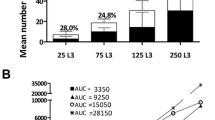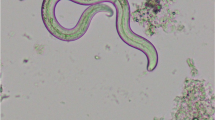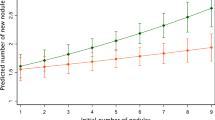Abstract
Increasing single doses of 5, 15, 30, 60 and 90 third-stageAcanthocheilonema viteae larvae per animal were inoculated into jirds. The adult worm load increased steadily, whereas the recovery rate decreased significantly, i.e. the correlation between dose and recovery was negative (r s, −0.90;n=5; α, 0.05). The same inoculation doses were given as trickle inoculations of 5 L3 each (3×5, 6×5, 12×5, 18×5) at intervals of 2–6 days throughout the prepatency period. Irrespective of the number of repeated inoculations, a rather constant but low load of 7–10 worms/animal was reached. The recovery rate decreased drastically (r s, −1.0;n=5). When trickle inoculations were carried out in animals exhibiting patient infections, the superinoculated larvae seemed to be destroyed almost completely; thus, a parasite-host equilibrium was guaranteed in all cases. The immunological background is discussed.
Similar content being viewed by others
References
Anuar KA, Katz SP, Orihel TC (1982) Influence of different inocula ofDipetalonema viteae on development of infection in the jirdMeriones unguiculatus. Procedings, 25th SEAMEO-TROPMED Seminar, Bangkok, pp 55–64
Barthold E (1990) Die defensive Komponente der Immunantwort nach Primo- und Superinokulation vonAcanthocheilonema viteae (Nematoda: Filarioidea) inMeriones unguiculatus. PhD Thesis, University of Tübingen
Barthold E, Wenk, P (1986) Quantitative relations in the extrinsic development ofDipetalonema viteae (Nematoda, Filarioidea) in the vector tickOrnithodorus moubata. Z Angew Zool 73:49–62
Carlow CKS, Philipp M (1987) Protective immunity toBrugia malayi larvae in Balb/c mice: potential of this model for the identification of protective antigens. Am J Trop Med Hyg 37:597–604
Denham DA, Ponnudurai T, Nelson GS, Rogers R, Guy F (1972) Studies withBrugia pahangi: II. The effect of repeated infection on parasite levels in cats. Int J Parasitol 2:401–407
Denham DA, McGreevy PB, Suswillo RR, Rogers R (1983) The resistance to re-infection of cats repeatedly inoculated with infective larvae ofBrugia pahangi. Parasitology 86:11–18
Denham DA, Suswillo RR, Chusattayanond W (1984) Parasitological observations onMeriones unguiculatus singly or multiply infected withBrugia pahangi. Parasitology 88:295–301
Eisenbeiß WF, Apfel H, Meyer TF (1991a) Recovery, distribution and development ofAcanthocheilonema viteae third and early fourth stage larvae in adult jirds. J Parasitol (in press)
Eisenbeiß WF, Apfel H, Meyer TF (1991b) The immunogenic and immune-susceptible larval stage ofAcanthocheilonema viteae in jirds. Proceedings, Spring Meeting of the British Society of Parasitology, Liverpool, April 3–5
Haque A, Ouaissi A, Santoro F, Des Moutis I, Capron A (1982) Complement-mediated leukocyte adherence to infective larvae ofDipetalonema viteae (Filarioidea): requirement for eosinophils or eosinophil products in effecting macrophage adherence. J Immunol 129:2219–2225
Jayasekera N, Kalpage KSP, De Silva CSS (1991) The significance of low density microfilaraemia in the transmission ofWuchereria bancrofti byCulex (Culex) quinquefasciatus Say in Sri Lanka. Trans R Soc Trop Med Hyg 85:250–254
Lucius R, Ruppel A, Diesfeld HJ (1986)Dipetalonema viteae: resistance inMeriones unguiculatus with multiple infections of stage-3 larvae. Exp Parasitol 62:237–246
Lucius R, Textor G, Kern A, Kirsten C (1991)Acanthocheilonema viteae: studies on the vaccination of jirds with irradiation attenuated stage-3 larvae and with exported larval antigens. Exp Parasitol (in press)
Maizels RM, Partono F, Oemijati S, Denham DA, Ogilvie BM (1983) Cross-reactive surface antigens on three stages ofBrugia malayi, B. pahangi andB. timori. Parasitology 87:249–263
Mössinger J, Barthold E (1988) Fecundity and localization ofDipetalonema viteae (Nematoda, Filarioidea) in the jirdMeriones unguiculatus. Parasitol Res 74:84–87
Neilson JTM (1976) A comparison of the acquired resistance toDipetalonema viteae stimulated in hamsters by trickle versus tertiary infections. Tropenmed Parasitol 27:233–237
Neilson JTM, Forrester DJ (1975)Dipetalonema viteae: primary, secondary and tertiary infections in hamsters. Exp Parasitol 37:367–372
Philipp M, Maizels RM, McLaren DJ, Davies MW, Suswillo R, Denham DA (1986) Expression of cross-reactive surface antigens by microfilariae and adult worms ofBrugia pahangi during infections in cats. Trans R Soc Trop Med Hyg 80:385–393
Rajasekariah GR, Monteiro YM, Netto A, Deshpande L, Subrahmanyam D (1989) Protective immune responses with trickle infections of third stage filarial larvae ofWuchereria bancrofti in mice. Clin Exp Immunol 78:292–298
Renz A (1987) Studies on the dynamics of transmission of onchocerciasis in a Sudan-savanna area of North Cameroon: III. Infection rates of theSimulium vectors andOnchocerca volvulus transmission potentials. Ann Trop Med Parasitol 81:239–252
Sachs L (1972) Statistische Auswertungsmethoden, 3. Auflage. Springer, Berlin Heidelberg New York
Tanner M, Weiss N (1981)Dipetalonema viteae (Filarioidea): development of the infective larvae in micropore chambers implanted into normal, infected and immunized jirds. Trans R Soc Trop Med Hyg 75:173–174
Vickery AC, Vincent AL, Sodeman WA Jr (1983) Effect of immune reconstitution on resistance toBrugia pahangi in congenitally athymic nude mice. J Parasitol 69:478–485
Weiss N, Tanner M (1981) Immunogenicity of the surface of filarial larvae (Dipetalonema viteae). Trans R Soc Trop Med Hyg 75:179–181
Wenk P (1991) The vector host link in filariasis. Ann Trop Med Parasitol 85:139–147
Wenk P, Mössinger J (1991) Recovery of adult stages and microfilaraemia after low dose inoculation of third stage larvae ofLitomosoides carinii (Nematoda: Filarioidea) inSigmodon hispidus. J Helminthol 65:219–225
Wong MM (1964) Studies on microfilaraemia in dogs: II. Levels of microfilaraemia in relation to immunotopic responses of the host. Am J Trop Med Hyg 13:66–77
Wong MM, Guest MF (1969) Filarial antibodies and eosinophilia in human subjects in an endemic area. Trans R Soc Trop Med Hyg 63:796–800
Wong MM, Guest MF, Lavoipierre MJ (1974)Dirofilaria immitis: fate and immunogenicity of irradiated infective stage larvae in beagles. Exp Parasitol 35:465–474
Author information
Authors and Affiliations
Additional information
Dedicated to Prof. Dr. J. Eckert on the occasion of 60th birthday
Rights and permissions
About this article
Cite this article
Barthold, E., Wenk, P. Dose-dependent recovery of adultAcanthocheilonema viteae (Nematoda: Filarioidea) after single and trickle inoculations in jirds. Parasitol Res 78, 229–234 (1992). https://doi.org/10.1007/BF00931731
Accepted:
Issue Date:
DOI: https://doi.org/10.1007/BF00931731




